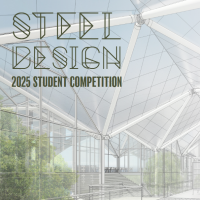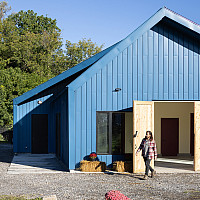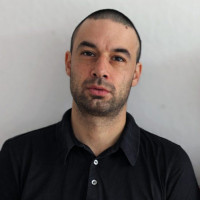The school’s 3D printers create models in resin, plastic or nylon powder. The printers are fee-based and open to Arch students and faculty, first-come-first-serve (no advance booking like the laser cutters). Preference is given to digital fabrication classes. Only architecture-related work will be printed (no ornaments, gifts for friends, jewelry, etc.).
3D Printer Types
We have several models to choose from. Factors to help you decide which model to use include: choice of material, length of time to print, cost, resolution, and how much work it takes to post-process the model after it leaves the printer.
1) formlabs form 2 & Form 3 - resin
The Formlabs Form 2 and Form 3 create models in white, black or clear resin. It uses a photopolymer-based process to shoot a laser across the liquid resin to solidify a thin layer, which is repeated to create the model. The technology is called stereolithography (SLA).
The support material is also resin and must be removed after the model is finished printing. It takes about 1-2 hours to print one inch in height, and the max model size in inches is 5.7 L x 5.7 W x 6.9 H. The cost is $0.15 per ml. Of the three types of printers, this produces models with the best resolution and durability, but is more expensive. Check the queue for the Form 2/3 here.
2) Formlabs Fuse 1 - Nylon Powder (laser sintering)
The Formlabs Fuse 1 makes models from a dark gray nylon powder, the layers of nylon powder are laser sintered together layer by layer. Models can be up to 6.3 L x 6.3 W x 11.6 H in inches. Time to print is approximately 2 hours per inch in height, but when finished, models require a couple of hours to cool down. The cost is $0.15 per gram. Wall thickness can be as thin as 1/16” of an inch. Models are strong and ready to be manipulated or painted after they have cooled down. Models are paintable. Check the queue for the Fuse 1 here. View the Fuse design guide.
3) Lulzbot - FDM (FUSED DEPOSITION MODELING)
The LulzBot Workhorse prints using a 3 mm bioplastic filament called PLA Polylactic Acid (in many colors!). Think of it as a hot glue gun that lays down plastic in 100 micron layers. Maximum build size in inches is 11 L x 11 W x 11 H. At 6 cents per gram, it’s very inexpensive. Time to print is approximately 1 hour per inch in height, although full size models can take 25 hours or more to print. The models are fairly durable, but removing the support material can be difficult. Check the queue for the LulzBots here.
Maximum Build Size (inches)
| Fuse 1 | Form 2, Form 3 | LulzBot | |
| X (length) | 6.3” | 5.7” | 11” |
| Y (width) | 6.3” | 5.7” | 11” |
| Z (height) | 11.6” | 6.9” | 11” |
Cost
The cost is based on volume or weight and will be calculated before it is printed. Fees are deducted from your lab printing account prior to printing. If there are insufficient funds in your account, the model will not be printed. The cost to build a model is usually cheapest on the LulzBot, followed by the Form 2/3, then the Fuse 1.
| Fuse 1 | Form 2, Form 3 | LulzBot |
| $0.15 per gram |
$0.15 per ml |
$0.06 per gram |
If you would like to know the cost prior to printing, be sure to check the appropriate box on the 3D Printer Job Submission Form and we will contact you.
Time to Print
Models take from 1-36 hours to print, based on size. We will attempt to print multiple models at once when possible. Students should plan to queue their files several days in advance of deadlines.In general, the Fuse 1 usually prints fastest, followed by the LulzBot, then the Form 2/3.
3D Printer Comparison
| Fuse 1 | Form 2, Form 3 | LulzBot | |
| Speed: | Medium | Medium | Medium |
| Cost: | High | Highest | Lowest |
| Durability: | Highest | Highest | Medium High |
| Resolution: | High | Highest | Medium |
| Post-processing: | Low to none | Moderate to High | Moderate to High |
How to Prepare Model for Printing
- Models are created in 3D programs such as Rhino and must be saved in the STL format. Use the following steps to prepare your model in Rhino.
- Make sure your model unit scale is in inches, not feet. Even though the dimension scale may be in inches, you still need to make sure the model units are in inches. In Rhino, type ‘units’ on the command line to change this. Your finished model size should be 1:1 with the size you want it printed.
- When working with surfaces, use BooleanUnion to combine the objects into one polysurface. Click Solid > Union. If the union doesn’t work, you will likely have errors and other problems later. Rework the model so that the union is successful before going on to the next step.
- After the Union command has been applied, create a Polygon Mesh. Highlight the object, select Mesh > From NURBS Object. With highly curved surfaces, increase the number of triangles in the mesh. Straight surfaces need less.
- Next, click the object to select the Polygon Mesh. With the mesh selected, drag it off the polysurfaces. Don’t forgot to do this, otherwise you may inadvertently export the surfaces along with the mesh!
- Issue the command CheckMesh to see if you have a good mesh. If you have a bad mesh, search Rhino help for ‘check/repair meshes’. This will give you many fix-it commands. A common problem is naked or unjoined edges, which are revealed with the command ShowEdges, and usually fixed with MatchMeshEdge. FillMeshHoles will repair holes, but is more likely to change the shape of the model. ExtractDuplicateMeshFaces will separate identical faces for easier removal, but be aware it could generate naked edges. It may be helpful to make a copy of the mesh before using these tools in order to check the results. Visit this page for more tips on creating a good STL file from Rhino.
- Check out this detailed guide on preparing your model in Rhino.
- When done fixing the model, export the Polygon Mesh as an STL file (export ONLY the mesh—make sure the polysurfaces aren’t underneath or you may get tons of errors when checking in Magics). Select the mesh, then click File > Export Selected. Change the Save As Type to STL. When the File Type Options appears, choose BINARY. Export each model to a separate STL—don’t combine them in one STL.
Use Magics to fix errors and check the model
- After creating the STL file, check the model in Magics, which is a software program available on the lab computers.
- Magics has a Fix Wizard which repairs common problems. Click Tools, Fix Wizard. Click Diagnose on the left, then click the Update button to see what errors are present.
- Ideally in Magics, you want to end up with zero errors in each category and one shell. If there are errors, you can click ‘Go to Advised Step’ to walk through the fix-it steps. Or you can pick an area listed on the left to work on, such as ‘Normals’, and try letting it automatically fix the errors. Each time you fix some errors, go back to Diagnose and reclick the Update button to check the error counts. Sometimes the automatic fixing can drastically change the model so use with care. There’s also a ‘combined fix’ but with more complex models this usually gives poor results.
- Other useful tools in Magics under the Tools menu are Triangle Reduction, Extrude, Offset Part, and Smoothing. If you make changes to the model in Magics, use File > Save Part As to keep it in the STL format.
How to Submit Your File - Drop Box and Job Form
- Copy your STL file into the ‘Drop Box - 3D Printer’ folder, which is found inside the ARCH-FILER\Student Drop folder on the G drive on the lab computers. Make sure the filename includes your NetID (i.e. jrsmith-myfile-01.stl).
- If you have several parts to print, put each part in its own STL file. Do not give us an STL file with multiple parts.
- Fill out online 3D Printer Job Submission Form
Post-production and model pick up
- Look to the 3D queue to see notification of completion.
- Form 2, Form 3, and LulzBot models may require trimming of the resin or plastic supports.
- All finished, printed parts will be placed on the cart for pick up. Please do not touch any other prints except your own.
Finishing Your Model - Painting, Sanding, Gluing
- Sanding - Sand the model to remove imperfections or layer lines from the surface. Wet sanding tends to keep the part cool and prevent melted material from “gumming up” the sand paper. It also minimizes dust. If you dry sand the part, wear a NIOSH-approved (or equivalent) dust mask.
- Painting - Before painting a part, wipe the surface with isopropyl alcohol and apply a lacquer-based paint primer. After priming, brush on any oil- or water-based paint that is compatible with the primer. Excellent painting results have also been achieved with air brushes and water-based acrylic paint.
- Gluing - Use “super glue” (cyanoacrylate) to join parts. Wipe the mating surfaces thoroughly with isopropyl alcohol before gluing for a stronger bond.
Refund Process
Refunds will be granted only if the printer malfunctions. Models that are delicate and may not print successfully will be alerted by technician if you choose to proceed you are responsible for all charges. Errors in the STL file are a student’s responsibility.
Other places to 3D Print (no affilation with SOA)
- VPA Fabrication lab at the Warehouse, 443-0479
- SU Makerspace - Marshall Square Mall (720 University Ave). Hours M-F, 1pm-5pm
- CADimensions - 6310 Fly Rd, Syracuse. 434-9787
- Shapeways (online)
- 3dprintingpricecheck.com - compares pricing for multiple services











